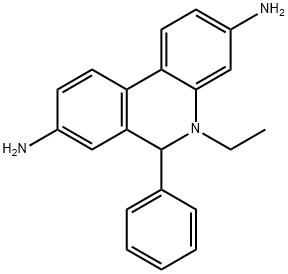| Identification | Back Directory | [Name]
DIHYDROETHIDIUM | [CAS]
104821-25-2 | [Synonyms]
PD-MY 003
Hydroethidine,98%
HYDROETHIDINE™
DIHYDROCYCLOSPORINH
(DIHYDROETHIDIUM BROMIDE)
DIHYDROETHIDIUM, FOR FLUORESCENCE*
hydroethidine(dihydroethidiumbromide)
5-ethyl-6-phenyl-5,6-dihydrophenanthridine-3,8-diaMine
3,8-Phenanthridinediamine,5-ethyl-5,6-dihydro-6-phenyl-
2,7-Diamino-10-ethyl-9-phenyl-9,10-dihydrophenanthridine 3,8-Diamino-5,6-dihydro-5-ethyl-6-phenylphenanthridine Hydroethidine | [Molecular Formula]
C21H20BrN3 | [MDL Number]
MFCD00077335 | [MOL File]
104821-25-2.mol | [Molecular Weight]
394.308 |
| Chemical Properties | Back Directory | [Appearance]
pink to purple fine crystalline powder | [Boiling point ]
580.4±50.0 °C(Predicted) | [density ]
1?+-.0.06 g/cm3(Predicted) | [storage temp. ]
−20°C
| [solubility ]
acetonitrile: soluble
| [form ]
powder | [pka]
5.30±0.40(Predicted) | [color ]
Pink to dark brown | [λmax]
355 nm | [BRN ]
5107482 | [Biological Applications]
Apoptosis assay; generating and detecting reactive oxygen species (ROS); detecting nucleic acids,cells; measuring respiratory burst; superoxide indicator; viability assay |
| Hazard Information | Back Directory | [Chemical Properties]
pink to purple fine crystalline powder | [Uses]
Redox indicator. Blue fluorescence until oxidized to ethidium. Can be used for detecting superoxide radical in cells, tissues and organisms. |
|
|





